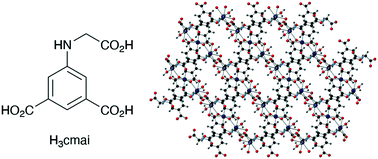Synthesis, structures and properties of metal–organic frameworks prepared using a semi-rigid tricarboxylate linker†‡
Abstract
The metal–organic frameworks formed from the reaction between cadmium(II) salts and the semi-rigid 5-((carboxymethyl)amino)isophthalic acid (H3cmai) in water at 90 °C are dependent on the counter-ions, with [Cd2(Hcmai)2(H2O)2]·H2O (1), [Cd(Hcmai)(H2O)2] (2) and [Cd3(cmai)2(H2O)4]·4H2O (3) forming from the nitrate, chloride and the acetate salts, respectively. Compound 3 loses both lattice and coordinated water molecules on heating to 150 °C and is converted into [Cd3(cmai)2] (4). This reaction occurs in a single-crystal-to-single-crystal manner and was followed using variable temperature X-ray powder diffraction. The reaction of cadmium(II) nitrate with H3cmai in a mixture of water and DMF afforded [Cd6(cmai)4(H2O)9.75(DMF)2.25]·18H2O·1.5DMF (5) whereas the same reaction in water and DEF in the presence of 4,4′-bipyridine led to [Cd3(cmai)2(H2O)3]·6H2O (6). Generally, the coordination networks containing Hcmai (1–2) propagate in one or two dimensions, whereas those containing cmai (3–6) propagate in three dimensions. Use of the first row d-block salts zinc(II), copper(II) and cobalt(II) nitrate resulted in compounds [M(Hcmai)(H2O)x] (M = Zn, x = 2 (7), M = Cu, x = 1.2 (8), M = Co, x = 2 (9)), with 8 showing photocatalytic activity for the degradation of the dye rhodamine B. Finally, the reaction of zinc(II) acetate with H3cmai in water and DEF yielded [Zn2(cmai)(OH)(H2O)2]·3H2O (10). Compounds 7–10 all form two-dimensional networks.

- This article is part of the themed collection: Paul R. Raithby at 70: in celebration of a life in chemistry


 Please wait while we load your content...
Please wait while we load your content...